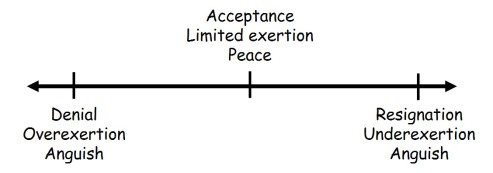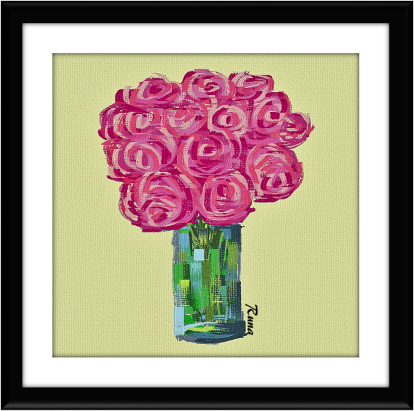The journey towards acceptance of a chronic illness is a long one, with shifting goalposts, and an uncertain finish line. It takes strength and persistence to overcome the loss of a life that could have been, and embrace a new one. All of us who have been battling chronic illnesses are full of stories of how we conquer it everyday to find our center of gravity and come to terms with a difficult situation.
In the last few weeks, I have deliberated much on how I have come to accept that a chronic illness invades my body. Yet, in accepting the illness, I have not allowed it consume me, refusing to give in to a “fibromyalgiac” identity. It may be one of my identities, but I am made of so much more that FM cannot extinguish within me! Accepting that dichotomy within me has been key in being able to nurture my health as well as my other interests that make up the rest of me.
To wrap up my Acceptance series of articles, then, today I talk about what helped me achieve a state of acceptance on some consistent basis, and some of the things that helped me embrace my new life with fibromyalgia.

1. Education: It can be hard to accept a strange, unfamiliar diagnosis as the illness that we suffer from. Therefore once I had a name, a diagnosis, I could look up, I tried to learn as much as possible about my condition. As a scientist, I was already trained in reading primary literature. So I hit the medical journals, and sought out the latest, most definitive research on fibromyalgia, in an effort to know all there is know about the condition. This helped me make sense of the myriad symptoms of fibromyalgia, which in turn informed the problem-solving approach that is central to my definition of acceptance. It also helped me feel less crazy, and like I had more of a ground to stand on against the “doubters.”
2. Writing/Blogging: It is difficult to accept a relatively rare condition when you feel all alone, dealing with it by yourself, surrounded by people who think you should probably just be able to suck it up. The graduate school environment, in particular, promotes stoicism, which is likely to encourage you to deny anything is wrong at all. This, of course, is a recipe for disaster. Through my blog, I have been able to make friends who share similar struggles, whom I can learn from and support in return, and around whom I can allow myself to admit my “true” state of being. Out here in the blogosphere, I do not have to pretend to be OK when I am really not. I have also found writing to be a cathartic experience in itself. It helps me sort my thoughts out, make sense of what is going on in my head, and create a journal of experiences that occasionally helps me see how far I have come. The blog creates a space which encourages me to acknowledge the struggles that come with the illness, and find ways to overcome them – both of which are, again, central to my definition of acceptance.
3. Focusing on something other than myself: Over time, this has taken various forms, such as helping other people, and immersing myself in a process, such as art or science or writing. It makes me feel connected with something bigger than myself (e.g. art, humanity, learning), which then helps me feel like there is a place for me in this world, even with my illness and all. Especially in helping other people, I find I am able to cultivate more compassion, not only towards others but also towards myself. It refocuses attention away from myself, so my own problems do not consume me. Also, it helps me see that many others have similar or worse problems than my own. In recognizing that, I have felt less alone, less self pity, and more self-compassion. Altogether, it has helped me place myself and my problems in perspective, which in turn has aided in accepting the new life that I have been dealt.
4. Meditation: I have had particular success with two types of meditation: (1) Mindfulness; and (2) Visual Imagery. Each in its own way has helped to bring a kind of clarity in my mind, without which it would have been really difficult for me to deal with my condition. Meditation helped me detach from myself at times, focus and break through the pain on others, so that together, they have provided some perspective on my new life and its new issues. It helped me see my problems as tractable ones, and promoted a kind of adaptiveness, that I believe is key to being able to accept any new (and less than welcome) situation.
5. Seeking the many levels of my mind: We all have the capability of living many levels in our heads. We are, in one sense, our thoughts, which are akin to a film playing on a movie screen. In observing our thoughts, we watch this film. And in being able to change our thoughts, we play the part of the one controlling the projector who determines what film to play. Through cultivating mindfulness into my life, I have come to identify with many parts of myself. There is one part of me that is in pain, another who is observing me experiencing the pain, a third who is controlling what I think or feel regarding the pain, so on and so forth. This exercise has been instrumental in me being able to identify myself as being more just than my illness, which was crucial for me to be able to accept my problems without feeling resigned towards them.
In tandem with each other, these five “activities” really helped me come to terms with the battle with a chronic illness. They helped me make sense of what I was feeling physically and emotionally. In being able to see my problems in perspective, and as tractable, manageable issues, I felt I could give myself permission to accept that indeed the problems existed, and that I am not giving up the fight by accepting their existence. Indeed, by acknowledging my chronic condition, and its associated limitations, I am finally opening myself up to finding new ways of overcoming those limitations.
All in all, being able to accept my current life has brought with it a level of internal peace and happiness that was missing from my life before. I know that happiness and acceptance have very personal meanings for each person dealing with their own situation. Even so, I hope that my musings can help somebody, who is struggling and is in search of peace, trigger some thoughts of their on these issues, which helps them find their version of peace they seek.
Love,
Fibronacci
MORE IN THE ACCEPTANCE SERIES:
Part I: A Lesson in Perspective and Acceptance
Part II: What is “Acceptance”?
Part III: How Acceptance can lead to Happiness
Part IV (A): Seeking a State of Acceptance
Part IV (B): Fighting the Denial of a Chronic Illness
READ MORE ON ACCEPTANCE AND HAPPINESS:
On Acceptance and Healing
What does it mean to be chronically ill and happy?










